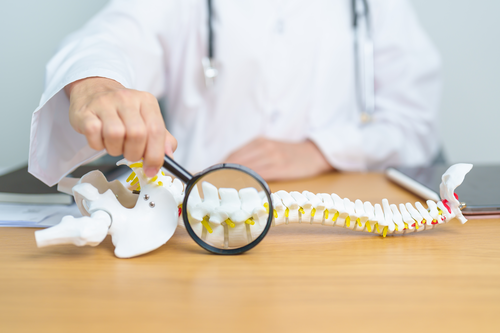Osteoporosis is characterized by weakened bones, which makes you more prone to fractures and breaks. Unfortunately, it’s a disease that progresses without symptoms, so it can be hard to detect. However, there are ways to practice osteoporosis prevention.
This post will give you five tips for osteoporosis prevention and how to keep your bones healthy.
Osteoporosis
What is Osteoporosis?
Osteoporosis is a condition where bones become weak and brittle due to bone density loss. Bone mineral density is a critical factor in diagnosing and managing osteoporosis, as it measures the amount of minerals in the bones, indicating their strength and risk of fractures. It’s a silent disease as it often progresses without symptoms until a fracture occurs. Commonly affected bones are the spine, wrists and hips. These fractures can cause severe pain, reduced mobility and long term disability.
Causes and Risk Factors
Osteoporosis occurs when the body loses bone mass faster than it can replace it, leading to a gradual loss of bone mass. Key factors are calcium and vitamin D deficiency which are essential for bone health. Achieving peak bone mass by around age 30 is crucial as it results in having more ‘bone in the bank’ and lowers the chances of developing osteoporosis as you age. Age is another factor; bone density decreases as we age. Women, especially postmenopausal women, are at higher risk due to lower estrogen levels. Other risk factors are genetics, smoking, excessive alcohol consumption, and a sedentary lifestyle.
Osteoporosis Symptoms
Early Stage Symptoms
Osteoporosis is called a “silent disease” as it often progresses without symptoms. In the early stages, bone density decreases without any pain or discomfort. Most people are unaware they have osteoporosis until a fracture occurs.
Physical Changes
As osteoporosis progresses, some physical changes may be visible. These are a gradual loss of height and a stooped or hunched posture, known as kyphosis. This curvature of the spine is due to the weakening and compression of the vertebrae. Back pain can also develop, often from minor fractures in the spine.
Fracture Risk
One of the most obvious symptoms of osteoporosis is increased fracture risk. Bones with osteoporosis are more prone to breakage from minor falls or even simple actions like bending over or coughing. Common fracture sites are the hip, wrist and spine. These fractures can occur with minimal trauma and may heal slowly, resulting in prolonged discomfort and disability.
For severe osteoporosis, treatment options include medications such as anabolic drugs, bisphosphonates, selective estrogen receptor modulators (SERMs), hormone therapy, denosumab, calcitonin, and anabolic agents like parathyroid hormone and romosozumab, along with lifestyle changes.
Impact on Mobility and Independence
Frequent fractures and the resulting pain can greatly impact mobility and independence. People with advanced osteoporosis may find it hard to do everyday tasks and may need assistance with things they can do on their own. Loss of independence can also cause emotional distress and reduced quality of life.
Detecting Symptoms Early
Early detection of osteoporosis symptoms is key to management. Regular bone density screenings can detect bone mass decrease before fractures occur. Knowing the risk factors and seeking medical attention if physical changes or unexplained back pain develops can catch osteoporosis in its early stages and prevent further bone loss.
Impact of Osteoporosis
Osteoporosis goes beyond physical health, it affects a person’s quality of life. Fractures can cause chronic pain, loss of independence and emotional distress. The risk of further fractures increases after the first break, creating a cycle of injury and recovery that can be debilitating. Preventive measures and early intervention is vital to minimize these risks and maintain bone health.
Osteoporosis Diagnosis
Bone Density Testing
The primary way to diagnose osteoporosis is through a dual-energy X-ray absorptiometry (DXA) scan, also known as bone density testing. This test measures the density of bones in the spine, hip and sometimes other sites. It’s a quick and non-invasive procedure that gives a clear picture of bone health. The result is given as a T-score which compares bone density to the average peak bone density of a healthy young adult. A T-score of -2.5 or below is osteoporosis.
Risk Assessment
In addition to bone density testing, healthcare providers assess individual risk factors for osteoporosis. These are age, gender, family history and lifestyle factors such as diet, exercise, smoking and alcohol consumption. Women especially post-menopausal women are at higher risk, as are men with low testosterone levels. Certain medical conditions and medications like long-term corticosteroid use also increase risk.
Physical Examination
A physical examination can help identify osteoporosis. Doctors look for physical changes such as a stooped or hunched back and measure height loss over time. Back pain and tenderness may indicate vertebral fractures. A comprehensive medical history including previous fractures and family history of osteoporosis helps in diagnosis.
Laboratory Tests
Laboratory tests are sometimes done to rule out other conditions that may cause bone loss and to check for underlying conditions that may contribute to osteoporosis. Blood tests can measure calcium, vitamin D and other bone turnover markers. These tests help in understanding overall metabolic health and guide treatment decisions.
Follow-Up and Monitoring
Once diagnosed, follow-up is crucial to manage osteoporosis. Regular bone density testing every one to two years helps to track the progression of the disease. Treatment plans are adjusted based on the results to ensure optimal bone health and reduce the risk of fractures.
Why Early Detection is Important
Early detection of osteoporosis is key to preventing complications. Identifying and treating the condition before significant bone loss occurs can reduce the risk of fractures and maintain quality of life. Those at higher risk should get bone density testing earlier and more frequently so timely intervention and management of osteoporosis can be done.
Osteoporosis Prevention Tips
1. Eat a Healthy Diet
A balanced diet rich in calcium and getting enough vitamin D is important for osteoporosis prevention. Calcium can be found in dairy products, leafy greens, and fortified foods. Vitamin D, which helps the body absorb calcium, is obtained from sunlight and foods like fatty fish and fortified cereals. Postmenopausal women and men over 70 years should aim for 800 IU of vitamin D daily to reduce bone loss and fracture risk. If dietary intake is not enough, supplements may be needed. Consult with a healthcare provider to determine the right dosage.
2. Exercise Regularly
Regular physical activity is essential for osteoporosis prevention. It maintains healthy bones and muscles, improves balance, and reduces the risk of falls. Weight-bearing exercises like walking, running, and stair climbing are best. Resistance training with weights or resistance bands helps maintain muscle mass and bone density. Balance and flexibility exercises like yoga and tai chi can also prevent falls. Aim for at least 30 minutes of exercise most days of the week.
3. Stop Smoking and Limit Alcohol Consumption
Smoking hastens bone loss by interfering with the body’s ability to absorb calcium and increasing bone destruction. Quitting smoking can reduce these risks. Excessive alcohol consumption also harms bone health by disrupting calcium balance and hormone regulation. Limit alcohol intake to no more than two drinks a day and have several alcohol-free days a week for osteoporosis prevention.
4. Monitor Bone Health
Regular bone density screening is important especially for women 65 and above and men 70 and above. These tests can detect early signs of bone loss so timely intervention can be done. If you are at higher risk due to family history, previous fractures or long term use of corticosteroids, discuss earlier screening with your healthcare provider. Early detection can prevent further bone loss and reduce risk of fractures. Regular screenings are crucial for osteoporosis prevention, helping to maintain bone density and reduce the risk of fractures.
5. Lifestyle and Environmental Changes
Creating a bone friendly environment can prevent falls and fractures. Make sure your home is free of tripping hazards, install grab bars in bathrooms and use non-slip mats. If needed, use assistive devices. Prioritize quality sleep as it is important for overall health and bone health. Aim for 7-8 hours of restorative sleep each night and address sleep disorders with your healthcare provider.
Additional Tips
Reducing cola and excessive caffeine intake can help osteoporosis prevention as these can harm bone density. Being underweight or overweight can increase risk of osteoporosis. Staying hydrated is good for overall health and helps in nutrient absorption including calcium. Additionally, certain breast cancer treatments, such as aromatase inhibitors like letrozole and anastrozole, can increase the risk of osteoporosis-related fractures, making it crucial to monitor bone health.
Visit our Atlanta Spine and Orthopedic Clinic Today!
At Georgia Spine and Orthopedic, we understand how developing osteoporosis can be worrying. We are here to take care of you and give you expert advice from our orthopedic surgeons to prioritize your bone health. It is crucial to treat osteoporosis to maintain bone health, so we encourage you to seek professional help for the best preventive and treatment measures.
Schedule an appointment at 678-929-4494 today!






